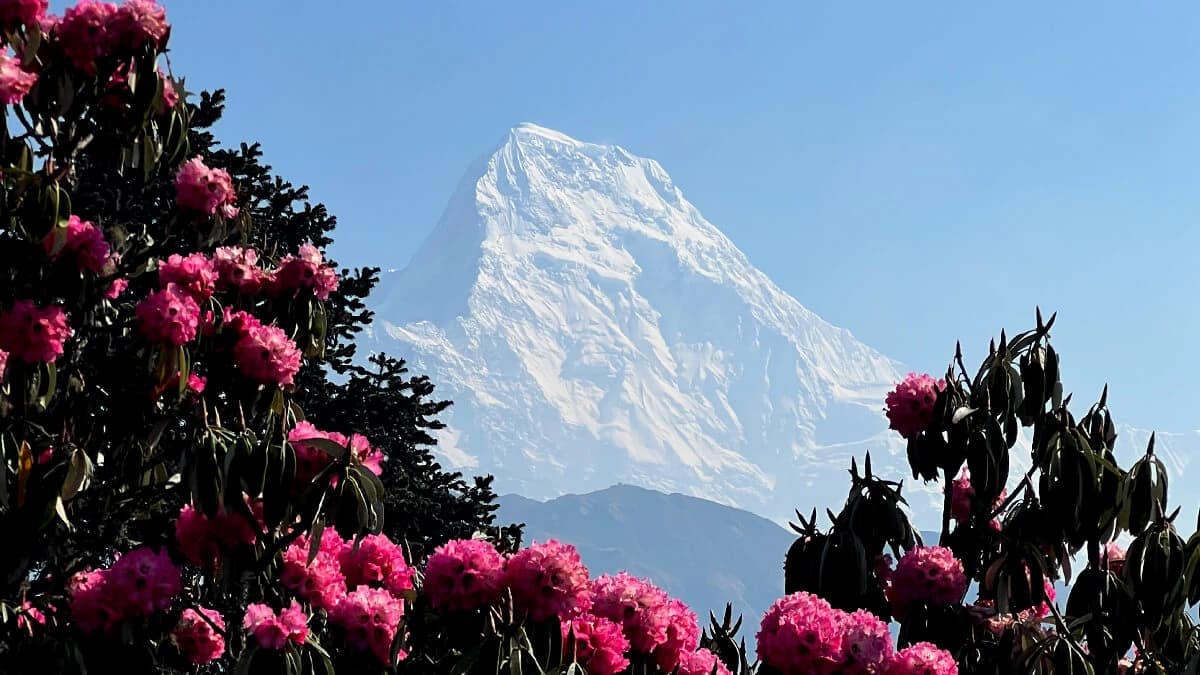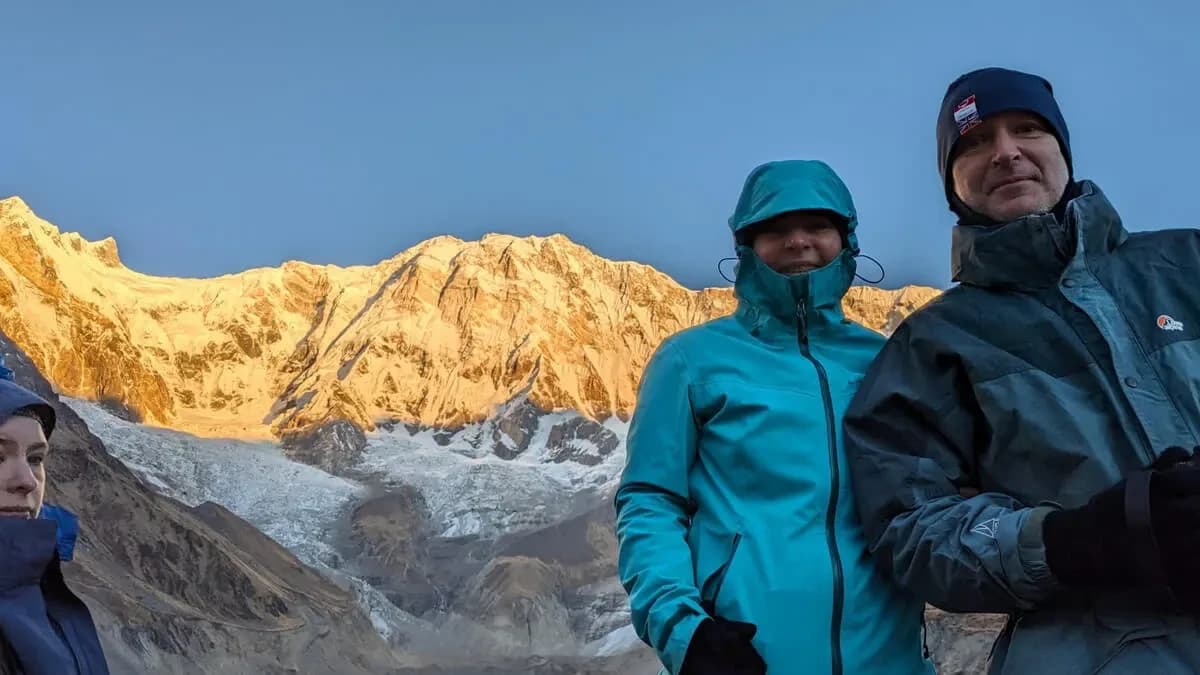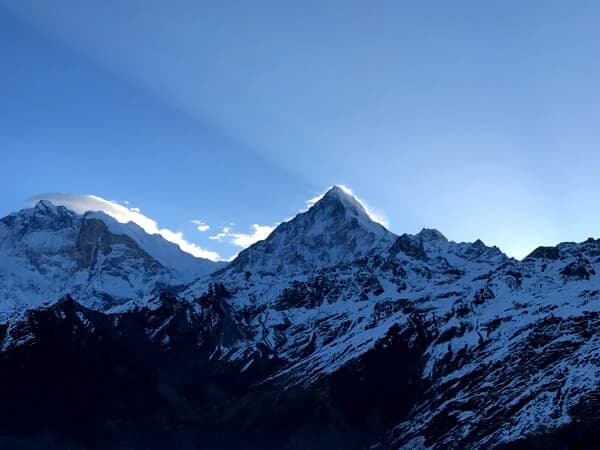Have you ever imagined standing on the foothill of Annapurna I (8091m)? Join us to fulfill your dream trip to Annapurna Base Camp.
The 10 Days Guided Annapurna Base Camp Trek (ABC Trek) is one of the most scenic and beginner-friendly high-altitude treks (4,130m) that takes you through lush green hills, glacial rivers, rhododendron forests, and traditional Gurung and Magar villages deep in the Annapurna region of Nepal. Annapurna Base Camp is surrounded by stunning views of Annapurna I, Tharpu Chuli, Annapurna Dome, Gangapurna, Fishtail, Annapurna III, and many smaller mountains. It is also known as the Annapurna Sanctuary trek.
The Annapurna Adventure is perfect for novices, moderately fit hikers, photographers, nature lovers and every trekker who wish to get immersed in the cultural and natural beauty of Nepal. Watch over the beautiful sunrise over Annapurna I, gaze into the stars poured like silver dust across the dark, descend to soak yourself in the Jhunu Danda hot spring, walk in the quiet trails of ABC, and engage yourself in the local culture to experience the full pleasure of the Annapurna Base Camp trek.
Solo or group, this trek doesn’t limit the size of trekkers. Local teahouses are the only accommodation where trekkers stay during their journey. They offer comfortable twin-sharing rooms, clean bedding and warm blankets. Dining is communal with hearty Nepali Daal- Bhaat and continental foods are served. The western and squad toilet facilities are available in every teahouse. Spring (March- May) and Autumn (September- November/ early December) are considered the best seasons due to its clear weather, blue skies, dry trails, and beautiful mountain views.
This guide contains day- to –day itinerary, answers to FAQs, along with practical understandings to help you plan a safe, scenic and sustainable trek with Global Eco Trails- a local expert for Annapurna trekking.
What are the Key Features of Annapurna Base Camp Trekking?
- Enjoy the panoramic views of the mountains and the breathtaking sunrise from Poon Hill
- Experience the world's 8th highest Mt Annapurna Base Camp and immerse in its charming silence
- Enjoy the Sunset and sunrise from Annapurna Base Camp over the Mountain.
- Enjoy being at Natural Hot Spring and relieve your muscle pain.
- Panoramic views of Annapurna I, Annapurna South, Machapuchare (Fishtail), Mardi, Hiunchuli, and Gangapurna.
- Rich biodiversity, with rhododendron forests, lush valleys, and alpine meadows.
- Experiencing the local culture and customs- memories that will last a lifetime!
Is Annapurna Base Camp Treks for me?
- If you want to experience high-altitude without experiencing extreme difficulty, then this trek is for you! Though there are steep ascents and rugged trails, with 5 to 7 hours of daily hiking required, a good guide and a good itinerary helps you complete the trek in given time.
- If it’s your first time trekking in Nepal, then this is the best classic trek where you can experience the natural amphitheater of mountains.
- If you want to escape your everyday life and find yourself in nature, then this trek is your piece of cake.
- If you don’t only want to find yourself in nature but also want to experience new, warm, hospital local culture, then yes, ABC is for you.(You can immerse yourself in Gurung and Magar culture of Nepal.)
- If you’re a kid around 10 years or an old soul who likes to hike, well, it is for you too!
Best Time to Trek Annapurna Base Camp (ABC)
The most favorable seasons for high-altitude trek are: Spring (March- June) and Autumn (September- December) due to clearer weathers, dry paths, good visibility and moderate temperature. However, every season has something to offer during the trek.
The spring season is clear, the temperature is moderate, and blooming Rhododendron and Orchid creates vibrant landscapes.
Autumn Season offers scenic landscapes, breathtaking mountain views, pleasant weather, and dry trails.
Monsoon Season offers heavy rainfall making the path wet and slippery but you’ll find wildflowers blooming along the trails.
Winter Season trek can be challenging due to the freezing temperatures, requiring proper trekking gear and preparation for you.
Accommodation during the trek
- Annapurna Base Camp accommodation ranges from basic teahouses to slightly more comfortable lodges.
- In the lower sections of the trek, you'll have access to attached bathrooms with hot and cold showers, but at higher altitudes, the accommodations are simple yet cozy.
- The twin bedroom comprises a mattress, a bed sheet, a pillow with its cover, and a small blanket occasionally.
Do I Need Acclomatization Day During The Trek?
Remember to walk in a slow and steady pace without hurrying. Take rest whenever you feel tired. Hydrate yourself. Eat carbs. Do not drink alcoholic beverages as symptoms of Acute Mountain Symptom includes unstable walk. Stick to your itinerary unless your guides agrees to amend it. However, spending a night at Machhapuchre Base Camp (3,700 m/12,135 feet) will reduce the chance of altitude sickness. Machhapuchre Base Camp (MBC) to ABC is approximately 3 km and takes 3 hours to reach. Spend a full day at Annapurna Sanctuary and enjoy the vibrant colorful sunrise and sunset.
Is It Dangerous to Spend a Night at Base Camp?
No, It is generally considered safe trekking destination. The Guest Houses are built at a distance from the glacial moraine. Slow ascent, proper warm clothes, recognizing the AMS symptoms, and keeping hydrated will make your Annapurna Base Camp Trek safe and successful. Trek with a well-trained guide who can recognize the altitude symptoms and take immediate action if required.
Do I need a guide for the Annapurna Base Camp Trek?
Yes, a guide is mandatory for the Annapurna Base Camp trek, as the route passes through canyons, valleys, jungles, slopes, and high-altitude areas. A local guide from a registered trekking company is recommended for safety and cultural insight. A storytelling guide is your companion who provides cultural insights, entertains, and acts immediately to handle emergencies.
Why Choose Us for ABC Trek?
Global Eco Trails is a locally owned, eco-friendly, and government-registered trekking company based in the heart of the country. ABC Trek is a top-selling trekking package, and we guarantee 100% safety with a customizable itinerary and private group tours at a fair price—no hidden costs.Global Eco Trails offer the trip extension option to Khopra Danda and Mardi himal Trek.
Annapurna Base Camp Outline Itinerary:
| Day | Route | Walking Distance | Duration | Destination altitude |
| 01 | Kathmandu to Pokhara ( Tourist Bus) | 200 KM | 8 hours | 810 m |
| 02 | Pokhara to Ulleri(drive), trek to Ghorepani | 12 km | 5 hrs | 2,780 m |
| 03 | Ghorepani to Poonhill to Tadapani | 10 km | 5 hrs. | 2,670 m |
| 04 | Tadapani to Chhomrong to Sinuwa | 10 km | 5 hrs | 2,350 m |
| 05 | Sinuwa to Deurali | 15 km | 7 hrs | 3,100 m |
| 06 | Deurali to MBC to ABC | 16 km | 7 hrs | 4,130 m |
| 07 | ABC to Bamboo | 18 km | 7 hrs | 2,310 m |
| 08 | Bamboo to Chhomrong to Jhinu Danda | 14 km | 6 hrs | 1,750 m |
| 09 | Jhinu Danda trek to Siwai and bus to Pokhara. | 55 km | 4 hrs | 810 m |
| 10 | Pokhara-Kathmandu (Tourist bus) | 200 km | 8 hrs. | 1,350 m |
10 days Annapurna Base Camp Package Trek Cost
The trek costs vary depending on several factors like Trekking seasons, Trek duration, required services, the mode of transportation, number of participants, type of trekking, and many more. However, our 10 days package starts from USD 655/- per person, including the below-mentioned services.
What Our Clients Say!
I am a solo traveler, and my Annapurna Base Camp Trek for 10 days was the highlight of my Nepal trip. My Guide and porter were excellent & everything was handled professionally. Highly recommend this company. Andy-norway
ABC Trek was unreal! I enjoyed every moment. The Sunrise and sunset view from Annapurna Base Camp is something I will never forget. Lisa Wolfgang-Finland
10 Days Annapurna Base Camp Package Cost
The trek costs vary depending on several factors like Trekking seasons, Trek duration, required services, the mode of transportation, number of participants, type of trekking, and many more. However, our 10 days package starts from USD 450/- per person, including the below-mentioned services.
ABC Trek Booking Procedure
The Annapurna Base Camp Trek booking procedure is very simple. Contact our experts with any questions you may have. For a confirmed booking, you need to send a trip deposit, a passport copy, and one passport photograph. The rest of the info our expert will pass to you through WhatsApp or email. Our customer service is available 24/7.
Finally, whether you are a first time trekkers or seasoned trekkers, 10 days Annapurna Base Camp Trek in Nepal is suitable for all. Please contact our experts for customizes itinerary, special group cost and the alternative trek route that you have in your mind syncronize in the plan at the time of booking your Annapurna Base Camp Adventure.












